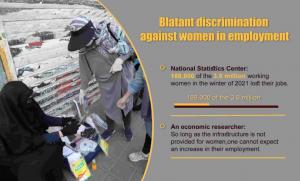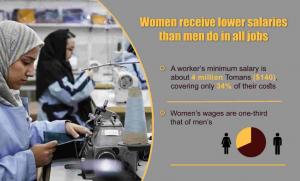International Day for the Eradication of Poverty: Iran, Where People Sell Their Hearts Due to Poverty

(NCRI) and (PMOI / MEK Iran): "Overcoming, poverty in contingent upon overthrowing the clerical regime and establishing people's sovereignty, in which case all of our nation's resources will be utilized for advancing and improving people's lives in Iran."
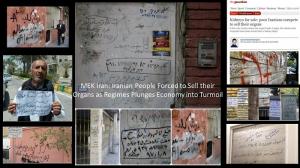
(NCRI) and (PMOI / MEK Iran): Shockingly, poverty in Iran has become so extreme that people are being forced to sell their organs just to survive. This father had put an advertisement to sell his heart to ensure the future of his family.
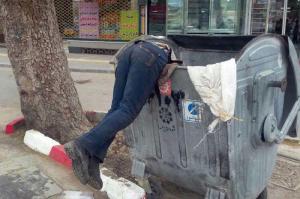
(NCRI) and (PMOI / MEK Iran): A man searching for leftovers inside a trash can, a very common scene in Iran today, due to government's corruption and spending the country's income to fund terrorism, development of Ballistic Missile programs, and domestic repression.
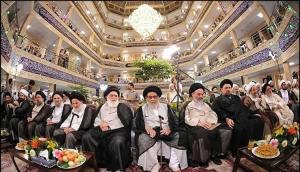
(NCRI) and (PMOI / MEK Iran): in an interview on September 19, 2021, with the state-run Aftab-News, Behzad Nabavi, a former high-ranking official, acknowledged that “In our country, there are four institutions which control 60 percent of the national wealth.
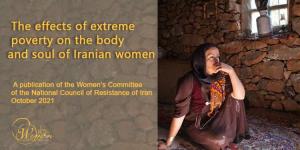
(NCRI) and (PMOI / MEK Iran): the spread of poverty in Iran and its “feminization,” we focus on this aspect of the human rights violations of the Iranian people by the mullahs’ regime.

(NCRI) and (PMOI / MEK Iran): The continuation of the mullahs’ rule will lead to a more bleak and dire situation for women in Iran. To survive, women will be compelled to gather garbage, work as human mules, sell their organs, prostitute themselves & sell their infants.
“Poverty, unemployment, and corruption were brought to our country by the religious fascism, and will continue as long as this medieval regime is in power.”
In an interview, a so-called “buyer” asks the man: “You know that if you sell your heart, you won’t survive. Don’t you?”
“Yes, I know what would happen…. I have tried many other ways and reached a deadlock. This is the only solution to ensure the future of my children,” the man responds. As a price for his heart, he gives one billion tomans or $367,000 with Iran’s free market’s current dollar exchange rate.
While October 17 marks the International Day for the Eradication of Poverty and many countries take serious steps toward this goal, in Iran, with its vast natural resources, Iranians are forced to sell body parts and vital organs to cover their expenses due to the rising poverty.
Selling body parts is not new in Iran. Walls across the country are covered with advertisements of people offering their organs, even vital ones such as bone marrow, heart, and cornea.
In an exclusive report in 2019, the Iranian Resistance underlined how selling body parts had become a lucrative business in Iran. According to the Iranian opposition, “Sellers are those in dire financial need for whom the organ market is the last resort. They are both male and female. Most of those willing to sell their kidney are young people between ages 22 and 34. But some older people want to sell their body parts too. Since organs offered by young people are not in short supply, buyers usually have no problem in finding what they want.”
“Amir, who is about 18 years old, has auctioned his kidneys due to poverty. He doesn’t want more than 500 million Rials. He says he can no longer cope with the landlord’s complaints. He and his brother have each decided to sell one of their kidneys and buy a small house with the help of a loan to relieve their mother from the suffering,” wrote the state-run Salamatnews on December 2, 2018.
What poverty means in Iran
More Iranians fall into the swamp of poverty every day as the Iranian regime continues devouring the natural resources and using them to fund its illicit activities. The poverty line in Iran varies from 10 to 15 million tomans. Meanwhile, the salary base of the Iranian workers and employees is around four million tomans.
According to the state-run Donyay-e Eghtesad on October 4, “official surveys show that the number of poor people has almost doubled from 2012 to 2019. During this period, 4 million people have been added to the poor, and the rise in poverty line has increased from 6.4% to more than 12%.”
On October 17, the state-run Mardom Salarie daily also confirmed that “Salaries are far less than the inflation rate. Thus, the large part of society, with the rising living costs and their fixed salaries, has fallen under the poverty line.”
“During the last forty years, the price index has increased about 1326 times,” wrote the state-run Etemad daily on Monday, October 11.
“A part of society hardly makes ends meet, while the elites go on luxury tours. Currently, there is no middle class in Iran. The poverty line has surpassed 11 million tomans. Evidence shows that a large part of society is below this line. Continuation of this trend divides the society into rich and poor sections. We could soon hear the breaking of poor people’s bones under this pressure,” Aftab-e Yazd daily wrote on October 6.
According to the state-run Jahan-e Sanat daily on October 2, “Iranians’ purchasing power has fallen sharply, and they are struggling to buy even the basic necessities of life, as the consumption of important food items such as meat, eggs, and dairy products on the Iranian table has dropped dramatically by as much as 50 percent.”
“The skyrocketing prices and the rising inflation rate have increased people’s living costs from 40 million tomans per year in 2018 to more than 63 million tomans in 2021,” wrote the state-run Kar-o Kargar daily on October 3.
Recently, regime officials tried to blame the increase in salaries for skyrocketing prices. Yet, according to the state-run Kar-o Kargar daily on September 21, adding “A 39% increase in salaries in 2021 will cover only 37 percent of the people’s cost of livelihoods. A worker’s salary of 4 million tomans covers only ten days of the month, and after that, the workers barely make ends meet until the end of the month. They have to remove many of the basic expenses from their lives.”
Where are Iran’s resources spent?
Iran is among the world’s richest countries in terms of natural resources. But, in an interview on September 19, 2021, with the state-run Aftab-News, Behzad Nabavi, a former high-ranking official, acknowledged that “In our country, there are four institutions which control 60 percent of the national wealth. This includes Executive Headquarters of Imam’s Directive (Setad Ejraie Farman Imam), Khatam al-Anbiya Base, Astan-e Quds, and Islamic Revolution Mostazafan (oppressed) Foundation. None of these institutions are in connection with the government or the parliament.”
In fact, these foundations are under the direct control of the regime’s supreme leader Ali Khamenei. Below are some facts about the amount of money these four institutions and their subsidiaries control:
Reuters investigation published in 2013 estimated Setad Ejraie Farman Imam assets to be worth around $95 billion. To strengthen the financial backbone of Setad, in 2010, Khamenei transferred close to $1B worth of assets from Astan-e Abdol-Azim in Rey city to Setad.
The Ministry of Roads and Urban Development announced on November 1, 2016, that it had awarded another massive development project to the Mostazafan Foundation. The Ministry of Roads and Urban Development announced on November 1, 2016, that it had awarded another massive development project to the Mostazafan Foundation.
Large swathes of farmland in northeastern Iran, estimated to be at least 990,000 acres with an estimated value of over $20B, are owned by Astan-e Quds. Additionally, 43.5 percent of Mashhad city’s urban land is under the foundation’s ownership. It also has endowments in 14 provinces, real estate offices in 20 provinces, and 300,000 rentals.
State-run news agency IRNA quoted the director of the National Iranian Oil Company as saying that the Khatam Headquarters’ oil contracts had surpassed $25B.
One might argue that international sanctions have also damaged Iran’s economy. This fact could only be considered if the regime had not enough resources to address the Iranian people’s problems. Besides, sanctions are in place due to the regime’s malign activities, such as the export of terrorism. So, the regime could have all the sanctions lifted by only stopping its illicit activities.
In 2019, the United States State Department estimated that Tehran gives $700 million a year just to the terrorist Hezbollah group in Lebanon.
While the Iranian people are being crushed under poverty, Reuters reported in December 2020 that the IRGC intends to spend $600 million in Iraq to expand the holy shrine of Imam Hussain, the third Shi’ite Imam.
As the state-run Eghtesad-e Pouya wrote on October 4, “Most of our economic problems have internal roots, and even sanctions are not the main cause of these problems.” It further confirmed that “Most of the sanctions are imposed due to our ideology, and obviously, standing up for ideology will incur costs. But the debate is not about why and how the sanctions are imposed. The question is why do we refuse to take safe paths against sanctions and impose a lot of economic costs on the country?”
In other words, the Iranian regime has enough resources, even now, to address people’s problems.
The International Day for the Eradication of Poverty on October 17 was signed in 1987 when a hundred thousand people gathered at the Trocadéro in Paris to honor the victims of extreme poverty, violence, and hunger. They underlined that poverty is a violation of human rights and affirmed the need to come together to ensure that these rights are respected. Since then, people around the globe and many governments have used the occasion to reaffirm their commitments to eradicate poverty and provide people with equal opportunities.
Yet, this has not been the case in Iran under the mullahs’ regime. People commit suicide, sell their body parts, or search for food in garbage bins. The Iranian regime is the source of Iran’s increasing poverty, and it is the regime that should be eradicated in Iran to end all miseries.
Iranians strive for the day when no father would have to sell his heart to secure the future of his family, and no mother would have to sell her dignity to make ends meet, and parents wouldn’t be ashamed to look into their children’s eyes.
The ongoing poverty in Iran has increased society’s restiveness. The world has witnessed major uprisings in Iran in the last two years. There are ongoing protests in Iran by people from all walks of life. Thus, the people’s hatred toward the regime increases parallel to poverty in Iran and it’s upon the global community to preserve the status quo or help to change it.
Mrs. Maryam Rajavi the President-elect of the National Council of Resistance of Iran’s (NCRI), tweeted:
"Poverty, repression, and COVID19 are rampant in Iran".
“Poverty, inflation, unemployment, and corruption were brought to our country by the religious fascism, and will continue as long as this medieval regime is in power.”
"Overcoming Coronavirus, as is the case with overcoming poverty and high prices in contingent upon overthrowing the clerical regime and establishing people's sovereignty, in which case all of our nation's resources will be utilized for advancing and improving people's lives in Iran."
...........................................................................................................................................................
The Women’s Committee of the National Council of Resistance of Iran published a report titled, "The effects of extreme poverty on the body and soul of Iranian women":
A brief look at the spread of extreme poverty in Iran and its “feminization,” as a human rights violation in Iran by the mullahs’ regime.
On October 17, 1987, more than 100,000 people gathered in Trocadero Square in Paris to commemorate the victims of extreme poverty, violence, and hunger. This demonstration led to the creation of the World Day to Overcome Extreme Poverty, officially recognized in 1992 by the United Nations as the “International Day for the Eradication of Poverty.”
For this reason, with a brief look at the spread of poverty in Iran and its “feminization,” we focus on this aspect of the human rights violations of the Iranian people by the mullahs’ regime. The gross and brutal manifestations of human rights violations in Iran make poverty a secondary issue. However, the study of the spread of extreme poverty among the Iranian people especially Iranian women can be a strong and sufficient reason for the illegitimacy of the mullahs’ rule over this rich nation.
Even though the information and statistics that have been collected, do not tell the whole story, but since it is entirely extracted from the comments of government officials, experts, and the regime’s own media, it can show the immense human tragedy being unfolded in Iran.
Overview
Only a few months into the formation of Raisi’s government, the upward trend in prices has taken a new momentum. The prices of the items in the basket of consumer goods for people’s daily needs have increased by 10 to 50 percent.
The cost of living in Iran has increased by 32%.
The overall quality of life in general and the lives and livelihoods of deprived women and families, especially in the context of both poverty and the pandemic, has moved the boundaries of disaster. Most people are in dire need of food, housing, medical care, clothing, and necessities of life and their situation is deteriorating by the day.
The coronavirus epidemic has plunged many businesses on the verge of bankruptcy leading to many people losing their jobs and incomes. During this period, many families in Iran are dealing with a decline in their income while facing a significant rise in the price of everyday household items. For example, the price of some food items has risen by 90% and the housing rental has multiplied.
The rising poverty line and rampant inflation in Iran are among the main causes of the phenomenon known as child marriages. About the increment of the poverty line, it can be discussed that “If the poverty line of a family of four in the country at the beginning of this year was estimated to be 12 million Tomans per month, today this line has reached 14 million Tomans per month.” said Mohammad Reza Mahboubfar.
Roozbeh Kordoni, the head of the Higher Institute for Social Security Research, said the number of people below the absolute poverty line in Iran has doubled.[4]
The first report of the Ministry of Labor and Social Welfare of Raisi’s government was published in August 2021. According to the report, the number of people below the poverty line in Iran in 2020 had reached 36 million.[5]
Meanwhile, Shahab Naderi, a member of the parliament in 2017, revealed that 80% of Iranian society lives below the poverty line.[6]
During the last four years with a complete economic collapse, the Iranian regime had no intention and wasn’t capable of improving the economic situation of the people. The economic statistics depict a horrifying condition of Iranian society.
The continuation of the mullahs’ rule will lead to a more bleak and dire situation for women in Iran. To survive, women will be compelled to gather the garbage, work as human mules, sell their organs, prostitute themselves and sell their infants amongst all kinds of other calamities.
To read the full report, and download the book, please click here
Shahin Gobadi
NCRI
+33 6 51 65 32 31
email us here
Visit us on social media:
Facebook
Twitter
What’s the price of the mullahs staying in power in Iran?
Legal Disclaimer:
EIN Presswire provides this news content "as is" without warranty of any kind. We do not accept any responsibility or liability for the accuracy, content, images, videos, licenses, completeness, legality, or reliability of the information contained in this article. If you have any complaints or copyright issues related to this article, kindly contact the author above.

